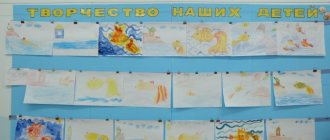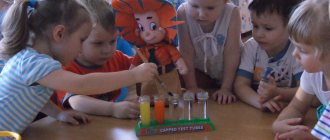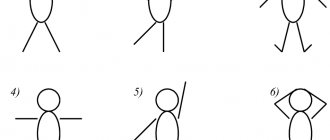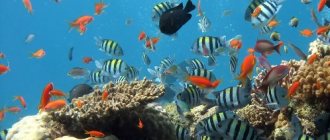Abstract of GCD on artistic creativity in the middle group on the topic “Goldfish”
Summary of GCD on artistic creativity in the middle group
Summary of educational activities on artistic creativity in the middle group on the topic “Goldfish”.
Author: Antonina Viktorovna Nedopekina, teacher at GBOU Kindergarten No. 1524, Moscow. Description of the material: I offer you a summary of direct educational activities for children of the middle group (4-5 years old) on the topic “Goldfish”. This material will be useful to middle school teachers, parents, and preschool children. This summary is aimed at cultivating the interest of preschoolers in artistic creativity. Goal: Image of a fish based on an oval and carefully painting over the shape, adding appropriate details (tail, scales, fins, eyes). Objectives: To clarify the idea of the appearance of fish. Develop a sense of shape and color perception. Continue to cultivate interest in co-creation with the teacher and with other children in creating a collective composition. Exercise children in selecting different shades of the same color. Develop a sense of composition (beautifully arrange fish by color one after another). Improve technical skills. Continue to develop the ability to examine and evaluate created images. Demonstration material: Illustrations depicting fish. Preliminary work: Feeding the fish in the aquarium and observing their behavior. Conversations about the appearance and lifestyle of fish. Looking at illustrations of fish. Reading a fairy tale by A.S. Pushkin “The Tale of the Fisherman and the Fish” Handout: “The bottom of the underwater world” depicted on a sheet of blue paper (35 cm by 55 cm format, for group work), gouache, a set of brushes No. 8, No. 3, jars of water, napkins. Progress of the lesson: Educator: Listen and guess the riddle. She wags her tail back and forth - And she’s gone, and there’s no trace. Children: Fish. Educator: Correct, what fish do you know? (Show a picture with fish)
Children: 1 - pearl gourami; 2 swordtail; 3 - molynesia; 4 - betta fish; 5 - guppy. Educator: Listen, which fairy tale by A. Pushkin is this excerpt from? For the third time he threw the net, - The net came with one fish, With a difficult fish - a gold one. Children: The Tale of the Fisherman and the Fish. Educator: Who is the fairy tale about? Children: About a goldfish. (Children briefly retell the plot of the fairy tale.) Educator: Where does the goldfish live? Children: In the underwater world. Educator: Let's take a look into the underwater world! What is happening there? How beautiful it is: there are colorful pebbles on the sandy bottom, green algae bending under the water. And who is this swimming? Gold fish. (Showing a blank for group work)
Educator: What color is the fish? Big or small? What do you think helps the fish swim? Children: Tail, fins. When a fish swims, its tail moves from side to side. (The teacher shows the movements of the fish with his hand and invites the children to also do with their hands like a fish with its tail)
.
Educator: Do you think the fish sees us? Children: Yes, because she has eyes. Educator: What do her eyes look like? Children: On small black beads. Educator. Do you want to play fish? Physical education minute: A rowan tree grew by the river (crouching, gradually straightening the torso, shaking your arms up).
And the river flowed and rippled
(with smooth movements of the hands in front).
Depth in the middle
(bends forward, arms straight).
Fish-na
(walking) was walking there.
This fish is not easy
(jumping).
It's called golden
(walking in place).
The fish swims in the water
(smooth movements of the hands in front)
The fish has fun playing
(jumping)
Fish, mischievous fish We want to catch you.
The fish arched its back, (bend back and stretch)
and winked at us with its eye.
The fish waved its tail, the fish quickly swam away. (Children pretend to be frolicking fish)
Educator: The goldfish wants to tell us something.
You see white bubbles rising from her lips. Oh, trouble, trouble! The fish lost its sisters, the goldfish. She is sad without them. Guys, we need to help the fish! Educator: Do you want to learn how to paint a Goldfish? ( showing a drawn sample of a fish)
Think about what form is the basis of its image?
Children: Oval. Educator: What else does the fish have? Children: Tail, scales, fins, eyes. Educator: I’ll try to draw a fish, for work I’ll take a large brush and yellow gouache. I will draw an arc on top and an arc on the bottom so that it turns out to be an oval. The arcs should intersect in one place, this will be the tail of the fish. (Showing the drawing sequence).
Educator: I carefully paint over the oval. And I let it dry.
Educator: Then I take a smaller brush and paint the fish’s tail and fins.
Educator: What else should I add to the fish? Children: Scales and eyes. Educator: Correct. The fish definitely needs to draw scales. (show) Educator: So I got a goldfish.
And now you try to draw the Golden Fish and her sisters, as you remember. But first, let's stretch our fingers. Finger gymnastics: “Fish” The fish swam and dived in clean, warm water (put your fingers together in a pinch, making wave-like movements with your whole arm - from the shoulder to the hand):
Then they will clench
(clench your fingers very tightly),
they will unclench
(spread your fingers to the sides),
then they will bury in the sand
(put your fingers together and alternately make movements with your hands, as if you were digging up sand). Educator: We've stretched our fingers, let's start drawing fish. ( Children draw goldfish. The teacher provides individual assistance, pays attention to how the children pick up paint and whether they are holding the brush correctly) Teacher: Well done, you painted beautiful fish! Guys, look, the Goldfish was happy that her sisters were found. She thanks you for your help. They can fulfill your wishes.
Educator: Guys, explain the proverb: “You can’t even pull a fish out of a pond without difficulty.” (Children explain the meaning of the proverb.) Educator: That’s right, if you try and work hard, then everything will work out. You learned how to draw Goldfish and helped the fish. Well done!
We recommend watching:
Outline of GCD for children of the middle group. Wild animals GCD outline for children of the middle group. My Homeland GCD outline for preschoolers of the middle group. Topic: Transport Summary of the GCD for children of the middle group “Geometric Kaleidoscope”
Similar articles:
Summary of lessons in kindergarten in the middle group. Profession rescuer
Summary of a lesson in kindergarten “Properties of wood.” Middle group
Lesson notes for the middle group of kindergarten
Lesson in the middle group of kindergarten. Professions of rural people
Lesson in the middle group on social and communicative development
Lesson summary “Where the fish live” for the middle group
"Where the Fish Lives"
Middle group
Tasks:
To form in children ideas about fish as living creatures living in water;
To develop knowledge about the characteristic structure of fish: body shape, fins, gills, etc.
Activate and enrich children's vocabulary.
To evoke a desire to take care of the riches of nature, to help understand that only then will there be a lot of fish in reservoirs, when the water in them becomes clean, and each fish will have the opportunity to leave offspring;
Cultivate an interest in nature.
Progress:
- Guys, today we will go on a water trip. What will you and I sail on? Children's answers: steamship, ship, boat. — That’s right, now you and I are going on a trip on a motor boat. - Get ready, take the steering wheel in your hands, start the engine (Children pronounce the sound “rrrr...”). Carefully! Turn - right, then - left, again - right, once again - left, now we are heading straight; turn off the engine... (children pronounce the sound "rrrr..." quieter and quieter). - And now we find ourselves on a pond (the teacher shows a magnetic poster “Reservoirs”). — Guys, what kind of reservoir do you think this is? Children's answers: river, pond, lake. - Indeed, guys, we found ourselves on a freshwater body of water (river or lake). Look how diverse and beautiful the flora and fauna on the pond are! - Please note that it is as if the reservoir is divided into two parts: one part is the surface and coastal ones, almost indistinguishable, the other is the underwater world. - Tell me the inhabitants of the surface world that you see in the picture. Children's answers: insects (water striders, butterflies and dragonflies, etc.), frogs, herons, beavers, water lilies, lilies, etc. - Tell me the inhabitants of the underwater world that you observe. Children's answers: snails, crayfish, river fish, swimming beetle, algae, etc.
Let's take a look at them. - Examination of illustrations, pictures depicting aquatic animals.
Guess the riddle: “Parents and children have all their clothes made of coins.”
Think and tell me how fish differ from other animals?
All fish are distinguished from other animals by common characteristics.
Invite the children to draw the body shape of a fish on the board (an option is a wind-up fish toy).
Look, the body is elongated, the head smoothly turns into the body, and the body into the tail. Fish have fins, scales, and gills.
—Have you ever picked up a fish? What does it feel like?
The body of the fish is covered with scales and mucus, this makes it slippery, so it glides easily in the water.
- The fish constantly lives in the water, there it finds food, in the water the eggs hatch into fry, from which a new fish then grows.
How does a fish breathe underwater? Has anyone thought about this?
- Yes, she has a special device for breathing under water - gills.
Consideration of the “Fish” model
Look at this diagram and tell us about the main distinguishing features of the fish.
Physical education
A fish lived in the lake, the fish swam to the shore, (legs shoulder-width apart, hands on the belt, bending to the sides) wagged its tail, looked for food for itself. (we jump our legs to the sides, together) There is a worm near the shore, Wriggling like this, (hands on the belt; we make circular movements with our hips to the left and right) The fish swims up, the worm is grabbed. (separate the wrists of the hands (open mouth) and connect them (closed mouth)) The fishermen pulled the fishing line, but the worm broke loose, (clap our hands in front of the chest and behind the back) The fish was not caught, I was left with the worm. (we make wave-like movements with our palms folded together: imitation of the movement of a fish)
Guys, tell me, what is needed so that the fish does not die, but lives?
Consideration of another model: “What is needed for fish.”
Discussion with children. Summarize that fish need water, food, air and aquatic plants.
Tell me, how does a fish appear? Examination of the model.
Yes, indeed, guys, fish emerge from eggs, eggs become fry, and fry grow into big fish.
Who knows the names of the fish? Name it!
How should people take care of fish so that they are happy and have babies? Will they be able to survive if the water in the seas and rivers is dirty? Can you do anything beneficial for the fish?
Game "We are fish."
Result:
What new did you learn? What were they talking about? What or who else do you want to know about?
Target. Formation of elementary mathematical concepts.
Tasks:
— Continue to develop the ability to count within 5 and correlate the number of objects with the numbers 1,2,3,4,5; correlate the shape of objects with known geometric figures (circle, square, triangle, rectangle).
— Develop the ability to compare objects by color, shape, size and spatial location; ability to determine spatial directions: right - left, top - bottom, etc.
— Reinforce the idea that the counting result does not depend on the distance between objects (within 5), the shape does not depend on the color and size of the object.
— Practice the ability to distinguish and name familiar geometric shapes: circle, square, triangle, rectangle.
Equipment: 20 paper fish of 4 colors: 5 yellow, 5 red, 5 green, 5 blue with the number of white circles in order: 1,2,3,4,5 in each color, 5 plastic buckets with numbers 1,2,3 attached ,4,5; Sheets with pictures of an aquarium with colorful fish, simple pencils for each child; 4 large multi-colored fish, each with a body of a different geometric shape: circle, triangle, square, rectangle and 5 small fish for each of the same shapes; counting sticks and a pattern of laying out fish on a sheet.
Organizing time.
Children stand in a circle, finger game “Fish”.
The fish swims in the water (palms together, imitation of swimming movements)
The fish have fun playing. (shaking palms)
Fish, fish, mischief, (they shake a finger)
We want to catch you. (palms alternately clenched into fists)
The fish arched its back (bending palms)
I took a bread crumb (grasping movements with a pinch)
The fish wagged its tail (wave-like movements with palms)
Quickly - quickly swam away. (hides hands behind back)
Task 1. Children, do you think it’s easy or difficult to catch a fish out of water? Why? Yes, you need to be attentive, patient, dexterous.
What do you call a person who knows how to fish? (fisherman). I offer you the game “Fishermen and Fishes”. Imagine that you are fishermen and there is a river in front of you (two tables with scattered paper colorful fish with different numbers of circles). Each fish has circles that need to be counted and placed in a bucket with the corresponding number. Let 1 - Vanya catch the first fish, count the circles out loud and find the right bucket. Then 2 - Ksyusha, 3 - Katya and 4 - Polina A. Now 5 - Misha T., 6 - Nikolina, 7 - Alisa, 8 - Vika L., 9 - Arina, 10 - Roma.
All the fish are placed in buckets. Let's check.
Approach the tables.
Task 2.
Sheets with pictures of an aquarium for each child, where 9 colorful fish swim: large and small, right and left, simple pencils.
1. Hide the fish that swim to the right in a circle, and the fish that swim to the left in a rectangle.
2. Count how many small fish (5) and how many big fish (5) there are? Which fish are there more, which are smaller? (equally)
3. Pay attention to the location of the fish in the aquarium. What size and color is the fish:
1-In the middle of the aquarium? Misha! (big yellow fish) Where is it? (in the middle of the aquarium)
2-In the upper right corner? Vika! (large white fish)
3-In the lower right corner? Alice! (big blue fish)
4-In the upper left corner? Ksenya! (big green fish)
5-In the lower left corner? Roma! (small yellow fish)
6-Between the big green one and the big white one? Katya (small red fish)
7-Under the big yellow fish? Vania! (big red fish)
8-Over the little white fish? Polina A.! (big green fish)
9-Between the big white fish and the big blue fish? Nikolina! (small green fish)
10- Between the little white fish and the little yellow fish? Arina! (small blue fish).
Well done! Now go out for a fun physical activity!
Physical exercise "Five little fish"
Five small fish splashed in the river (imitation of fish movement)
A large log lay on the sand. (hands to the side)
The first fish said: dive easily (tilt down while simulating diving)
The second said: but it’s deep here! (hands up with stretching)
The third said: I want to sleep, (put your hands under your ear)
The fourth began to freeze a little. (grab yourself by the shoulders and rub them)
The fifth shouted: there is a crocodile here! (imitation of the opening of a crocodile's mouth)
Swim quickly so you don't swallow it! (swing with straight arms)
Look, all the little fish in the river escaped from the crocodile, hid and now cannot find their mothers. Let's help the fry return to their mothers - fish.
The teacher places large fish in the form of different geometric shapes on each of the 4 tables: circle, square, rectangle, triangle. On the children's tables there are several small fish in the form of different geometric shapes and different colors.
Task 3.
Children, you know that fish come in different shapes: the ball fish is round, the angelfish is triangular in shape, we looked at the pictures.
Look, children, mother fish have different body shapes. But everyone has something in common. What is this? Tail. What shape is it? Triangular.
What shape is the body of this fish? Where is her mom? Help, Alice, find the fry its mother - a fish based on its body shape. Etc.
If fish could talk, they would thank you kids for your help!
Would you like to see more fish in our waters? Sit down at the tables and take multi-colored counting sticks.
Task 4. Place a fish according to the pattern on the table using counting sticks. Then three more fish according to your imagination.
Round dance game "Ruffs".
Move. Children stand in a circle, choose a leader with a counting rhyme, he stands in a circle, children walk in a circle and say:
There are reeds on the river,
Ruffs splashed there.
Older circle, younger circle,
There are just kids all around.
They look at each other
And everyone does it like this!
(Shows the movement, the children repeat, he looks and chooses as driver instead of himself the one who performed the movement best, the game continues 3 times.)
Children, did you enjoy working out? Which tasks were easy? Which ones are difficult? What's the most interesting thing? You did a very good job with all the tasks, well done!




